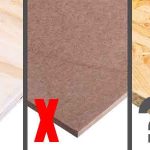The DIY Fix is reader supported. When you buy after clicking a link on our site, we may earn an affiliate commission.
Woodworm remains a mystery to most people. In most cases, people are unaware they have an infestation. This is because woodworm live inside timber and most people won’t check until they notice an issue.
It’s not until they notice weakened floorboards, or exit holes in other pieces of timber, that they realise they have woodworm. At this point, the damage is likely done, and the woodworms life cycle is almost finished before people are aware. This means that it is often too late, and damaged timber will need replacing.
So, how long can woodworm stay dormant?
The female woodworm lays its eggs in cracks in suitable timber. The eggs will then hatch, and the larvae will begin burrowing into the timber. Here they will begin eating the wood. At this point they may not see the light of day for several years.
So, they’re not completely dormant, they’re still active larvae and spend their time chewing through timber. Over a period of between two to five years (depending on the species), the larvae will live inside the timber. This is where they stay until they hatch into an adult beetle.
Does Woodworm Hibernate?
Most of a woodworm’s life is in larvae form and spent inside timber. It is here we might consider woodworm to be hibernating, However, it is at this time that they are actually very active.
Through this entire period the larvae eat timber. So, over the course of a long period of time, they can cause a lot of damage.
The time we think of as hibernation, is really the period when woodworm is most active. Unlike some animals and pests that sleep for several months, the woodworm is different. Their lifecycle means that they stay as larvae for many years before they hatch into an adult beetle.
How Long do Larvae Stay in Timber?
The main concern for homeowners is the time that woodworm can live in timber. The life cycle from birth, up to the moment they hatch and become an adult beetle is up to five years.
The adult beetle will lay eggs in cracks and existing holes in timber. This keeps the eggs safe and after several weeks, the eggs will hatch downward. They then become larvae and will begin a journey that lasts for several years.
The larvae are especially small, only around 2mm in size. They begin eating their way into the timber, causing the timber to weaken over the years. This is because they bore into wood in large numbers, causing a lot of damage.
Through this entire time, they remain inside the wood where they cannot be seen. There are signs we might spot, such as boreholes and frass. Frass is a waste product that woodworm produce when they chew through timber.
Can Adult Beetles Go Dormant?
The larvae will pupate towards the end of the two to five years. Prior to this, the larvae will begin its journey to the surface of the wood. Here it will create a pupal chamber. They make the tunnel large around them. This is where they will form into an adult beetle.
The adult beetle will then begin to eat through the final layer of timber. This is where you will see the exit holes, that indicate you have a woodworm infestation. It is only at this stage of the life cycle that you will be able to identify an infestation.
At no other point are you likely to realise you have woodworm. Furthermore, at this point, the damage to the timber has already been done.
Once the beetle emerges, they will not go dormant. They will begin looking for a mate to begin the cycle again.
How Long Do Adult Beetles Live For?
As adult beetles do not go dormant, it’s important to understand how long they live. To become an adult beetle, it will have taken many years. During this time, they chew through timber and cause damage. But adult beetles will cause very little damage during the remainder of their life.
In fact, the time they live as an adult beetle is very short. The female beetle will live for anything between ten and fourteen days. The male lives for an even shorter period of anything from three to four days.
The focus of their short adult lives is to mate. So, the male beetle will mate with as many female beetles as possible. This will result in many eggs being laid and hatched, and from here, the life cycle begins again.
Conclusion
The life cycle of woodworm can continue for many years. During this time, the larvae remain dormant in one way as they are rarely seen and are yet to hatch into an adult beetle.
However, they are still active, as this is the main period where they cause damage. They are never completely dormant, and they don’t hibernate in winter.
During this time period they can cause a lot of damage that can prove costly and dangerous.




